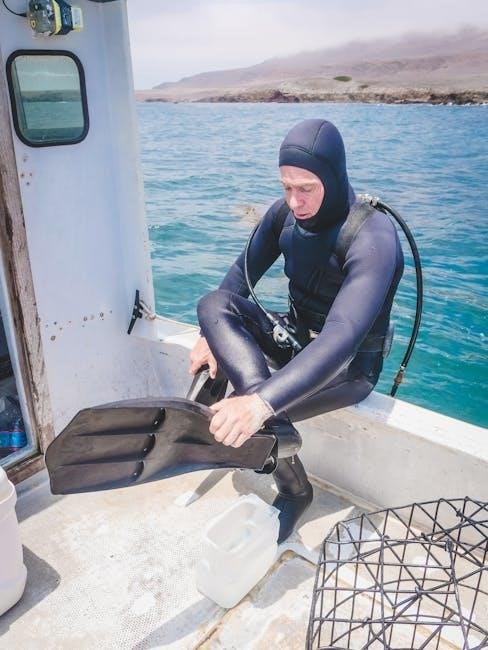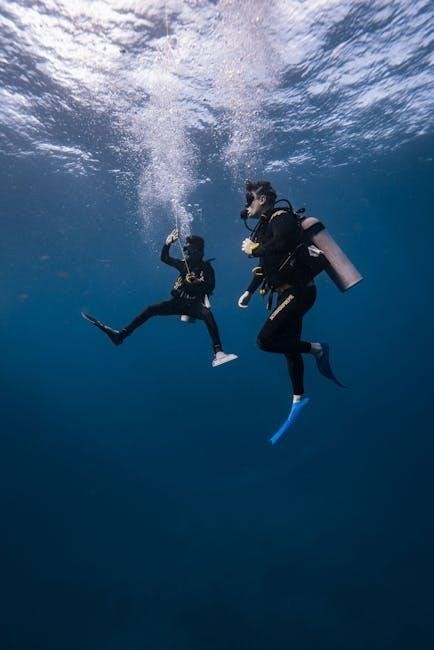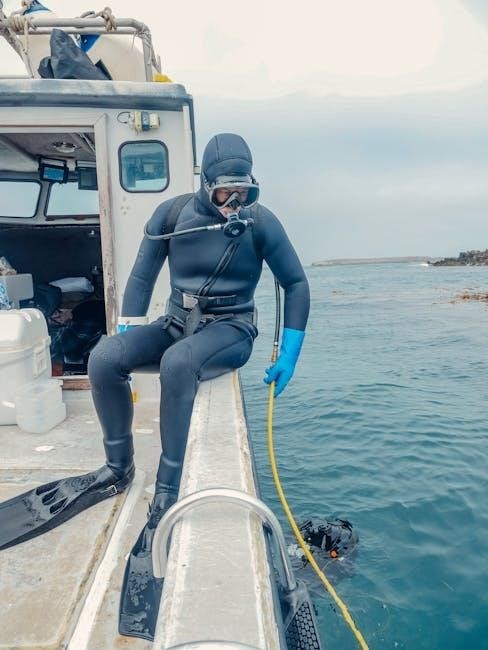wetsuit guide for water temperature
A wetsuit is essential for water sports, providing insulation and warmth in cold water. Its thickness determines heat retention, making it vital to choose based on water temperature.

1.1 Importance of Wetsuit Thickness in Different Water Conditions
The thickness of a wetsuit plays a crucial role in maintaining body heat in varying water temperatures. Thicker neoprene provides better insulation in cold waters, while thinner suits offer flexibility in warmer conditions. For surfing, a balance between warmth and mobility is key, whereas diving may require thicker neoprene for deeper, colder environments. Understanding the relationship between wetsuit thickness and water temperature ensures optimal performance and comfort during water activities. This guide helps determine the ideal thickness for your specific needs.
1.2 Brief Overview of Wetsuit Materials and Their Role in Insulation
Wetsuits are primarily made from neoprene, a synthetic rubber that traps warm water next to the skin, providing insulation. The thickness and density of neoprene determine its insulating properties. Thicker neoprene is used in colder waters to reduce heat loss, while thinner materials are suitable for warmer conditions. Additional materials like limestone-based neoprene offer enhanced flexibility and warmth. The combination of these materials ensures that wetsuits can adapt to various water temperatures, maintaining comfort and performance across different environments and activities.
Understanding Water Temperature Ranges and Wetsuit Needs
2.2 Temperate Waters (50°F-70°F/10°C-21°C): Mid-Thickness Wetsuits
Temperate waters require wetsuits with mid-range thickness, typically 3/2 mm, balancing flexibility and warmth. These suits are ideal for cooler conditions without sacrificing mobility, making them suitable for surfing or diving in these temperatures. Accessories like hoods or gloves may still be needed for added protection, depending on personal tolerance to cold. The 3/2 mm thickness ensures adequate insulation while maintaining ease of movement, making it a popular choice for waters in this temperature range.
2.1 Tropical Waters (Above 70°F/21°C): Thin Wetsuits and Accessories
In tropical waters, where temperatures exceed 70°F (21°C), thin wetsuits (1-2 mm) are ideal for providing minimal insulation while maintaining flexibility and comfort. These suits are lightweight and breathable, reducing heat buildup during intense activities like surfing or snorkeling. Accessories such as rash guards or board shorts can be added for sun protection and abrasion resistance without sacrificing mobility. The focus here is on comfort and flexibility, as the primary need is not warmth but protection from the elements and marine life. Choose a wetsuit that enhances your performance in warm, sunny conditions.

2.2 Temperate Waters (50°F-70°F/10°C-21°C): Mid-Thickness Wetsuits
In temperate waters, ranging from 50°F to 70°F (10°C to 21°C), mid-thickness wetsuits are ideal. These suits, typically 2-4 mm thick, offer the perfect balance of warmth and flexibility. They are suitable for a variety of activities such as surfing, diving, and general water sports. The added insulation keeps you comfortable in cooler conditions without restricting movement, making them versatile for different uses.
Additionally, the mid-thickness neoprene provides excellent thermal retention while maintaining maneuverability. This makes them a popular choice for athletes who need both protection and performance in moderate climates. Whether you’re surfing or engaging in other water activities, a mid-thickness wetsuit ensures optimal comfort and functionality in temperate waters.
2.3 Cold Waters (Below 50°F/10°C): Thicker Wetsuits and Layering
Cold water below 50°F (10°C) requires thicker wetsuits to maintain warmth and insulation. Typically, suits range from 5mm to 7mm in thickness, ensuring maximum heat retention. Layering with additional accessories like hoods, gloves, and booties enhances protection against the cold. These layers help prevent heat loss and provide extra comfort in freezing conditions.
Thicker neoprene suits are designed to withstand extreme cold, while layering allows for adjustable warmth. This combination is essential for prolonged exposure in cold water, ensuring both safety and performance during water activities.

Wetsuit Thickness Guide for Specific Activities
Wetsuit thickness varies by activity, with surfing favoring flexibility, diving needing durability, and general sports requiring versatility. Choose thickness based on activity demands and water conditions.
3.1 Surfing: Balancing Flexibility and Warmth
For surfing, wetsuit thickness must balance warmth and flexibility. Thinner suits (1-2mm) are ideal for warmer waters, allowing unrestricted movement. In colder conditions, thicker suits (3-4mm) provide insulation while maintaining flexibility. Neoprene quality and seam construction also impact performance. Surfers in frigid waters may opt for 5-6mm suits but risk reduced mobility. Choosing the right thickness ensures comfort and effectiveness in the water, tailored to specific conditions and personal preference.
3.2 Diving: thicker Neoprene for Deep Water Insulation
3.2 Diving: Thicker Neoprene for Deep Water Insulation
Diving requires thicker wetsuits to maintain warmth in deep, cold water. Suits typically range from 5mm to 7mm, with some extreme cases using 8mm for frigid conditions. Thicker neoprene provides superior insulation against cold water penetration, essential for prolonged dives. High-quality neoprene retains its insulating properties under pressure, ensuring consistent warmth. While thicker suits may reduce flexibility, they are crucial for protecting core body heat during deep-water activities. Divers often pair these suits with hoods and gloves for enhanced thermal protection.
3.3 General Water Sports: Versatile Wetsuit Options
For general water sports, wetsuits offer versatile options to suit various conditions. Thicknesses range from 1mm to 5mm, catering to different water temperatures and activities. Thinner suits (1-2mm) are ideal for warm waters, providing flexibility and minimal restriction. Mid-range suits (3-4mm) balance warmth and mobility for temperate conditions. Thicker suits (5mm+) are best for colder waters, ensuring maximum insulation. The choice depends on water temperature, activity level, and personal comfort, making wetsuits adaptable for diverse needs and preferences.

Additional Accessories for Cold Water Protection
Accessories like hoods, gloves, and booties enhance cold-water protection. Layering with rash guards or thermal tops adds warmth without compromising mobility, ensuring optimal comfort in chilly conditions.
4.1 Hoods, Gloves, and Booties: Essential for Extreme Cold
Hoods, gloves, and booties are crucial for protecting extremities in frigid water. They prevent heat loss, keeping heads, hands, and feet warm. Made from neoprene, these accessories trap warm water close to the skin, reducing cold penetration. Hoods cover the scalp and ears, while gloves and booties provide grip and dexterity. Together, they enhance overall warmth, making them indispensable for surfers, divers, or anyone in extreme cold. Investing in high-quality options ensures better insulation and comfort during prolonged water exposure.
4.2 Layering with Rash Guards and Thermal Tops
Layering with rash guards and thermal tops enhances warmth in cold water. These lightweight, breathable garments are worn under wetsuits, trapping warm water close to the skin. Made from materials like polyester or nylon, they wick moisture and dry quickly; Thermal tops add insulation without restricting movement, while rash guards provide UV protection and prevent chafing. Layering is ideal for cold-sensitive individuals or extended sessions in chilly conditions, offering versatility and comfort. This extra layer boosts warmth, ensuring optimal performance in cooler water temperatures.

Wetsuit Temperature Chart for Quick Reference
This chart provides a quick guide to wetsuit thickness based on water temperature, helping you choose the right suit for optimal warmth and performance in various conditions.
5.1 Standard Wetsuit Thickness Recommendations by Water Temperature
Water temperature significantly influences wetsuit thickness. For tropical waters (above 70°F/21°C), a 1-2mm suit is ideal. In temperate waters (50°F-70°F/10°C-21°C), 3-4mm suits are recommended. For cold waters (below 50°F/10°C), opt for 5-6mm thickness. These guidelines ensure proper insulation while maintaining flexibility. Thicker suits are essential for deeper diving, while thinner ones suit surfing. Always consider activity type and personal comfort when selecting thickness for optimal performance in varying conditions.
5.2 Adjustments for Personal Cold Sensitivity
Personal cold sensitivity plays a crucial role in choosing wetsuit thickness. Some individuals may prefer a thicker suit even in warmer waters, while others tolerate cold better. If you’re highly sensitive, consider adding 1-2mm to the standard recommendation. Layering with rash guards or thermal tops can also enhance warmth without sacrificing mobility. For example, in 60°F (15°C) water, a 3mm suit might be more comfortable than the standard 2mm for colder-sensitive individuals. Always test and adjust based on personal comfort to ensure optimal performance and warmth.
Maintenance and Care for Long-Lasting Wetsuit Performance

Regularly rinse your wetsuit with cold water and avoid harsh chemicals to preserve neoprene integrity. Store it in a cool, dry place, away from direct sunlight.

6.1 Cleaning and Storing Your Wetsuit Properly
After use, rinse your wetsuit with fresh, cold water to remove salt, sand, and bacteria. Avoid using harsh chemicals or hot water, as they can damage the neoprene. Gently scrub with a mild detergent if needed. Allow the wetsuit to dry completely, inside out, away from direct sunlight. Store it in a cool, dry place, hanging on a sturdy wetsuit hanger to maintain its shape. Proper care ensures longevity and maintains insulation performance.
6.2 Repairing Tears and Damage to Maintain Insulation
Inspect your wetsuit regularly for tears or abrasions. Small cuts can be repaired with neoprene repair kits, which include adhesive and patches. Clean the damaged area thoroughly before applying the patch to ensure a strong bond. For larger tears, professional repair may be necessary to restore insulation. Avoid using harsh chemicals or heat, as they can weaken the neoprene. Prompt repairs prevent water infiltration and maintain the wetsuit’s insulating properties, ensuring optimal performance in cold water conditions.
Choosing the right wetsuit involves understanding water temperature, activity, and personal comfort. Always consult a wetsuit thickness chart and test the suit for optimal fit and warmth.
7.1 Summary of Key Considerations for Water Temperature and Wetsuit Choice
When selecting a wetsuit, water temperature is the primary factor. Thicker suits are needed for colder waters, while thinner options suffice for warmer conditions. Always consult a wetsuit thickness chart to match your activity and climate. Personal comfort and sensitivity to cold also play a role, so consider layering or accessories if needed. Balancing warmth and flexibility ensures optimal performance. Adjustments may be necessary based on individual preferences and specific water sports requirements for the best experience.
7.2 Encouragement to Test and Adjust Based on Personal Comfort
Every individual’s sensitivity to cold varies, so it’s crucial to test your wetsuit in real conditions. If you feel too cold or restricted, consider a thicker suit or additional layers. Conversely, if overheating occurs, a thinner option might be better. Adjustments ensure maximum comfort and performance. Don’t hesitate to explore different styles or accessories until you find the perfect fit. Personal comfort is key to enjoying your water activities fully and safely, so take the time to tailor your gear to your needs.

